Family: Frankeniaceae
Frankenia cupularis
Citation:
Summerh., J. Linn. Soc. (Bot.) 48:371 (1930).
Synonymy: F. annua Summerh., J. Linn. Soc.(Bot.) 48:379 (1930); F. pseudoflabellata Summerh., J. Linn. Soc.(Bot.) 48:372 (1930); F. annua Summerh. var. orthotricha J. Black, Trans. R. Soc. S. Aust. 55:140 (1931); F. orthotricha (J. Black)J. Black, Trans. R. Soc. S. Aust. 56:43 (1932).
, Frankenia pseudo-flabellata Common name: None
Description:
Densely-branched small shrubs or subshrubs; branches differentiated into long- and short-shoots, glabrous to puberulent or short-pilose, hairs spreading to uncinate, internodes 3.5-35 mm long; leaves often few; long-shoot leaves 4-11.5 mm long; leaf bases medially somewhat thickened, flattened toward the margins, usually tapering somewhat toward the distal end, 0.7-2 mm long, 0.5-1.2 mm wide at the distal end; leaf blades oblong, ovate, oblanceolate or obovate to narrowly so, rarely linear, usually 1.7-3.5 or rarely 0.8-1.6 mm wide, flat or with margins loosely to tightly revolute; mid-vein narrow, linear, inconspicuous to abaxially raised; surfaces a greyish yellow-green, adaxial surface glabrous or with scattered short hairs, abaxial surface glabrous to puberulent; short-shoot leaves similar to long-shoot leaves.
Flowers usually borne in long irregularly and highly branched dichasia, subtended by whorls of 4 floral bracts connate at the base; floral bracts 4-10 mm long, blades ovate, oblong or obovate, 1-3 mm wide, mid-vein often more prominent than on leaves; calyces 5-lobed, tubular, indurate, 5-7.2 mm long, 1.5-2 mm wide, glabrous to lightly puberulent or short-pilose, hairs spreading to lightly curved; petals 5, spathulate, 6.3-10.5 mm long; stamens 6, in 2 unequal whorls, 4.3-7.7 mm long; styles 3.5-6.8 mm long; style-branches 3, 1-3.1 mm long; stigmas terminal, terete to lightly swollen at tips, 0.5-1.2 mm long; ovaries with 3 parietal-basal placentae, 1.3-1.9 mm high, extending up the lower one-half to two-thirds of the ovary wall; ovules 20-34, attached along the entire placenta by short erect to lightly curved funicles.
Published illustration:
Barnsley (1982) Flora of Australia 8:fig. 31.
|
|
Distribution:
|
S.Aust.: LE, GT, EA. N.T.; Qld.
|
Conservation status:
native
Flowering time: March — Dec.
|

SA Distribution Map based
on current data relating to
specimens held in the
State Herbarium of South Australia
|
Biology:
No text
Taxonomic notes:
Frankenia cupularis may be conspecific with F. pauciflora. However, awaiting further study, I have maintained it as a formal taxonomic entity here, since in S.Aust. it is morphologically and geographically distinct, albeit weakly so, from F. pauciflora. Frankenia pauciflora var. gunnii and fruticulosa are primarily coastal in distribution and have ovule numbers of 6-18, whereas F. cupularis is exclusively inland in distribution, occurring mainly in eastern S.Aust. north of Port Augusta, and has ovule numbers of 20-36. Detailed study of F. pauciflora over its entire range and of a group of closely related W.Aust. species including F. confusa, F. fecunda, F. hispidula, F. laxiflora and F. magnifica (many of which are difficult to distinguish) is needed to resolve taxonomic problems within this group.
Author:
Not yet available
|

